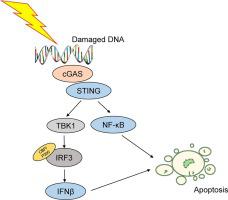Molecular Immunology ( IF 3.6 ) Pub Date : 2021-01-08 , DOI: 10.1016/j.molimm.2020.12.037 Can Li 1 , Weiwei Liu 1 , Fang Wang 1 , Toshihiko Hayashi 2 , Kazunori Mizuno 3 , Shunji Hattori 3 , Hitomi Fujisaki 3 , Takashi Ikejima 4

|
Exposure to ultraviolet B (UVB) from sunlight causes DNA damage, serious cellular inflammation and aging, and even cell death in the skin, commonly known as sunburn, leading to cutaneous tissue disorders. DNA damage can be sensed as a danger-associated molecular pattern (DAMP) by the innate immune system. It has not been studied, however, whether cGAS-STING activation is involved in the apoptosis induced by UVB irradiation or by cisplatin treatment. Here we report the findings that within hours of DNA damages keratinocytes show an innate immune response, which involves the activation of cGAS-STING; a cytosolic DNA receptor, cGAS (cyclic guanosine monophosphate-adenosine monophosphate synthase), cyclic GMP-AMP (cGAMP) synthase, and DNA sensing adaptor, STING (protein stimulator of interferon genes). Either UVB irradiation or cisplatin treatment can cause DNA damages, releasing fragmented DNA from nucleus and/or mitochondria. Roles of cGAS-STING were examined in the HaCaT cells with DNA damages caused by UVB irradiation or cisplatin treatment. Silencing STING by siRNA rescued HaCaT cells from UVB or cisplatin-induced apoptosis. NF-κB, one of the major downstream components of STING pathway, which usually regulates the classical STING apoptotic pathway, was translocated to nucleus in the HaCaT cells irradiated with UVB. This translocation was attenuated by STING silencing. Treatment with BAY, an inhibitor of NF-κB pathway, blocked UVB-induced apoptosis. cGAS-STING-mediated production of IFNβ was induced by nuclear translocation of interferon regulatory factor 3 (IRF3). UVB irradiation inceased the nuclear translocation of IRF3, accompanied by enhanced expression level of IFNβ mRNA. The nuclear translocation of IRF3 and expression of IFNβ mRNA were attenuated by STING silencing. Treatment with MRT67307, an inhibitor of TBK1-IRF3-IFNβ pathway, blocked UVB-induced apoptosis. Therefore, we conclude that NF-κB pathway and IFNβ pathway residing in the downstream of STING are resposible for apoptosis of UVB-irradiated or cisplatin-treated HaCaT cells.
中文翻译:

DNA损伤触发cGAS-STING通路激活诱导人角质形成细胞HaCaT细胞凋亡
暴露于阳光中的紫外线 B (UVB) 会导致 DNA 损伤、严重的细胞炎症和衰老,甚至皮肤细胞死亡,俗称晒伤,导致皮肤组织疾病。DNA 损伤可以被先天免疫系统感知为危险相关分子模式 (DAMP)。然而,尚未研究cGAS-STING 激活是否参与UVB 照射或顺铂治疗诱导的细胞凋亡。在此,我们报告了以下发现:DNA 损伤后数小时内,角质形成细胞表现出先天免疫反应,其中涉及 cGAS-STING 的激活;胞质 DNA 受体、cGAS(环鸟苷单磷酸-腺苷单磷酸合酶)、环 GMP-AMP (cGAMP) 合酶和 DNA 传感适配器 STING(干扰素基因的蛋白质刺激物)。UVB 照射或顺铂治疗均可导致 DNA 损伤,从细胞核和/或线粒体中释放碎片 DNA。我们在 HaCaT 细胞中检查了 cGAS-STING 的作用,该细胞因 UVB 照射或顺铂处理而造成 DNA 损伤。通过 siRNA 沉默 STING 可将 HaCaT 细胞从 UVB 或顺铂诱导的细胞凋亡中拯救出来。NF-κB是STING通路的主要下游成分之一,通常调节经典的STING凋亡通路,在UVB照射的HaCaT细胞中被转位至细胞核。这种易位通过 STING 沉默而减弱。BAY(一种 NF-κB 通路抑制剂)治疗可阻断 UVB 诱导的细胞凋亡。cGAS-STING 介导的 IFNβ 产生是由干扰素调节因子 3 (IRF3) 的核转位诱导的。UVB 照射增加了 IRF3 的核转位,伴随着 IFNβ mRNA 表达水平的增强。STING 沉默减弱了 IRF3 的核转位和 IFNβ mRNA 的表达。用 TBK1-IRF3-IFNβ 通路抑制剂 MRT67307 治疗可阻断 UVB 诱导的细胞凋亡。因此,我们得出结论,位于STING下游的NF-κB通路和IFNβ通路与UVB照射或顺铂处理的HaCaT细胞的凋亡有关。



























 京公网安备 11010802027423号
京公网安备 11010802027423号